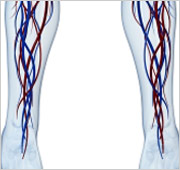 This is a test that uses ultrasound waves to measure the blood flow to the legs and feet. Peripheral vascular disease (PVD) is caused by atherosclerosis which causes a build-up of plaque inside the arteries that decreases the blood flow of oxygen and nutrients to the muscles and tissues of the legs and feet (this is called ischemia). The technologist will examine the patient’s feet and perform an ankle-brachial index test (ABI), if necessary. ABI determines the circulation of blood to the legs through the use of blood pressure cuffs and Doppler.
This is a test that uses ultrasound waves to measure the blood flow to the legs and feet. Peripheral vascular disease (PVD) is caused by atherosclerosis which causes a build-up of plaque inside the arteries that decreases the blood flow of oxygen and nutrients to the muscles and tissues of the legs and feet (this is called ischemia). The technologist will examine the patient’s feet and perform an ankle-brachial index test (ABI), if necessary. ABI determines the circulation of blood to the legs through the use of blood pressure cuffs and Doppler.
What patients require an extremity artery evaluation?
Doctors will request an evaluation of the extremity arteries on patients with symptoms of intermittent claudication (pain with walking), rest pain (leg pain that wakes a person up at night), or sores or ulcers that do not heal. Patients with vascular risk factors such as smoking, high blood pressure, diabetes, elevated lipids also apply.
What happens during an extremity artery evaluation?
You will be asked to lie down on an examination table. The technologist will try to feel the pulses in your feet. If the technologist is unable to feel pulses in the feet, he or she will perform an ABI test. The technologist will place blood pressure cuffs on your arms and ankles. Using the Doppler, the technologist will measure the systolic pressure in the ankles. The systolic pressure measurement in the ankle is divided by the systolic pressure measurement in the arm to get a ratio.
What are the risks of extremity artery evaluation?
Since the procedure is done without entering the body and does not use dyes or x-rays, there is no risk or pain involved in having an extremity artery evaluation.






